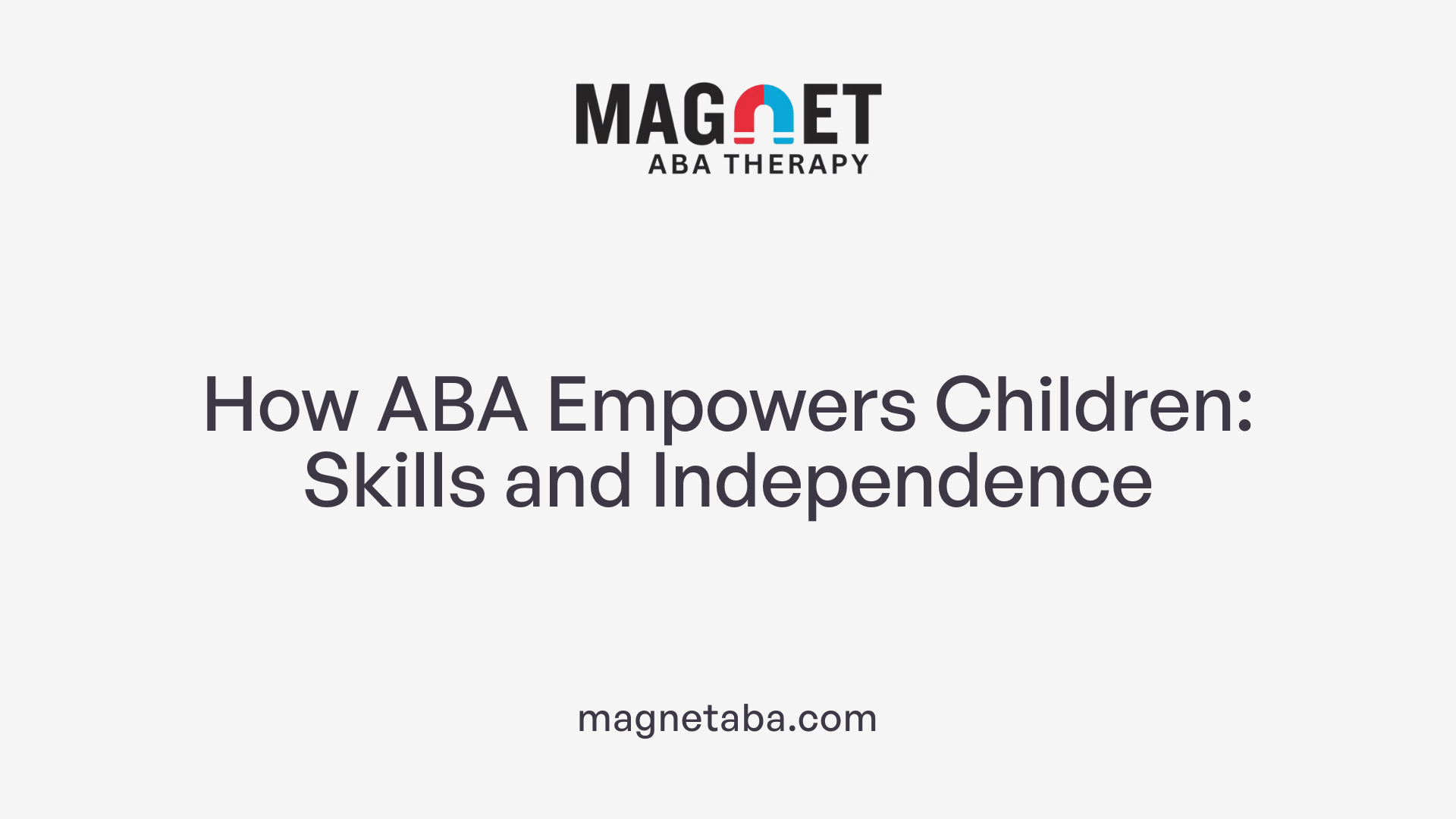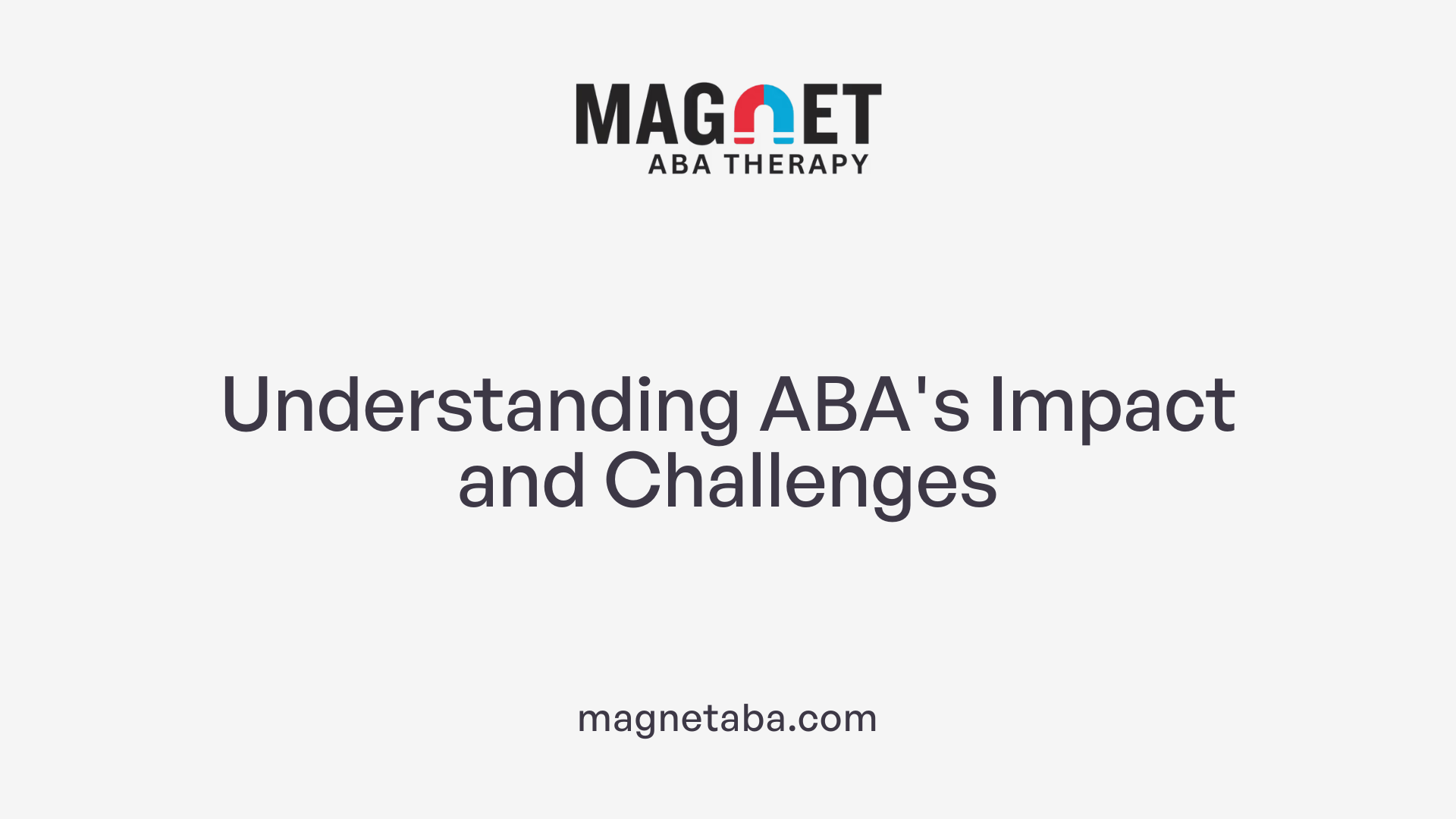Understanding the Role of Behavior and Medication in Autism Support
Supporting children with autism through medication changes requires a balanced, informed approach that combines behavioral therapies with careful medication management. While medications target associated symptoms such as irritability or anxiety, behavioral analysis therapy plays a crucial role in reinforcing positive skills and managing challenging behaviors. This article explores how behavior-based interventions like Applied Behavior Analysis (ABA) complement medication use, ensuring children receive personalized, effective care during transitions in treatment.
What is Behavioral Analysis Therapy for Autism?

Definition of Applied Behavior Analysis (ABA)
Behavioral analysis therapy for autism, widely known as Applied Behavior Analysis (ABA), is an evidence-based therapeutic approach grounded in principles of learning and behavior modification. ABA aims to help individuals with autism develop functional skills while reducing behaviors that interfere with learning and daily life.
Core goals of ABA
The primary objectives of ABA include enhancing communication, social interactions, attention, and adaptive behaviors. Therapy targets meaningful improvements that increase independence and quality of life, such as improving language use, social engagement, and daily routines.
Techniques used in ABA
ABA employs various techniques, including discrete trial training (DTT), which breaks skills into small steps with positive reinforcement; and pivotal response training (PRT), which emphasizes motivation and communication in natural settings. Positive reinforcement encourages desired behaviors by rewarding them, while unwanted behaviors are gently discouraged. A consistent system tracks progress and adjusts methods as needed.
Personalization and intensity of therapy
ABA programs are highly individualized, designed based on comprehensive assessments considering a child's unique strengths, challenges, and family context. The intensity of therapy varies but often involves several hours per week of one-on-one instruction spanning months or years to maximize gains.
Modern naturalistic approaches and positive strategies
Contemporary ABA prioritizes natural environments such as home or school and play-based interactions to make learning engaging and contextually relevant. These approaches focus on pivotal life skills like communication initiation and social motivation, aiming to generalize improvements beyond therapy. Importantly, positive, supportive techniques replace former aversive methods, fostering a respectful and encouraging atmosphere that promotes long-term independence and participation.
Who Provides Behavioral Analysis Therapy for Autism?

Professionals Involved in ABA Therapy
Behavioral analysis therapy for autism is generally delivered by trained experts in Applied Behavior Analysis (ABA). The primary providers are Board Certified Behavior Analysts (BCBAs) who specialize in designing and supervising personalized treatment plans. Alongside BCBAs, licensed behavior analysts and behavior technicians play essential roles in implementing daily therapy sessions.
Role of Board Certified Behavior Analysts (BCBAs)
BCBAs lead the process by assessing the child’s needs, creating tailored interventions, and continuously monitoring progress. They ensure that therapy goals are met through evidence-based strategies aimed at improving communication, social skills, and independent living abilities.
Settings Where ABA is Delivered
ABA therapy can be provided in a variety of environments to suit the child’s needs. Common settings include the child's home, schools, specialized clinics, and increasingly through telehealth platforms. These diverse locations help integrate learning into daily routines and natural surroundings.
Collaboration with Families and Multidisciplinary Teams
Successful ABA therapy involves strong partnerships with families and caregivers who support the child’s growth outside of sessions. Multidisciplinary teams, including speech therapists, occupational therapists, and psychologists, often collaborate with ABA providers to create comprehensive, cohesive treatment plans.
Together, these professionals and support systems work to deliver effective behavioral analysis therapy, enabling children with autism to develop vital skills and improve quality of life.
Common Techniques Used in Behavioral Therapy for Autism

What techniques are commonly used in autism behavioral therapy?
Autism behavioral therapy uses a range of structured and naturalistic approaches to improve communication, social interaction, and behavior.
Applied Behavior Analysis (ABA) and its variants
ABA forms the foundation of many behavioral therapies for autism. It encourages desirable behaviors through positive reinforcement while discouraging unwanted behaviors. Variants of ABA include:
- Discrete Trial Training (DTT): A highly structured method that breaks skills into small steps and teaches each step through repeated trials with clear rewards.
- Pivotal Response Training (PRT): A more naturalistic ABA approach conducted in everyday settings, focusing on pivotal areas like initiating communication to drive broader skill development.
- Positive Behavioral Support (PBS): Focuses on understanding the reasons behind behaviors and changing the environment to promote positive behaviors.
- Early Intensive Behavioral Intervention (EIBI): Designed for young children, providing intensive one-on-one instruction.
Developmental and educational approaches
These therapies focus on building communication and daily living skills:
- Speech therapy: Improves verbal skills as well as alternative communication methods like signs or electronic devices.
- Occupational therapy: Helps develop everyday skills such as dressing, eating, and social interactions. It often includes sensory integration to better process sensory information.
- Educational treatments: Approaches like the TEACCH method provide structured environments with visual cues and routines tailored for learners with autism.
- Early Start Denver Model (ESDM): Uses play-based interaction to foster social, language, and learning skills in very young children.
Social-relational and psychological treatments
Social therapies focus on emotional connection and social skills:
- DIR/Floortime: Emphasizes relationships and emotional development through interactive play.
- Social Stories and social skills groups: Help children understand social situations and improve peer interactions. Psychological treatments like Cognitive-Behavior Therapy (CBT) assist with managing anxiety, depression, and other mental health challenges often seen alongside autism.
Together, these techniques create a comprehensive and personalized approach to helping individuals with autism develop skills and reduce challenges effectively.
Benefits of Behavioral Analysis Therapy for Children with Autism

How does behavioral analysis therapy benefit individuals with autism?
Behavioral analysis therapy, especially Applied Behavior Analysis (ABA), offers extensive benefits for children with autism by focusing on skill development and reducing challenging behaviors through systematic methods. ABA encourages desired behaviors by using positive reinforcement, making learning a rewarding experience for children.
Skill development and behavior reduction
ABA breaks down complex skills into manageable steps, teaching each one systematically, which helps children acquire new abilities such as communication, social interaction, and daily living tasks. At the same time, ABA discourages undesired behaviors by ignoring or redirecting them, leading to improved behavior.
Improvement in communication and social skills
Forms of ABA like Pivotal Response Training (PRT) and Discrete Trial Training (DTT) specifically target communication and interaction skills. PRT focuses on pivotal skills such as initiating communication in natural settings, while DTT uses structured trials and rewards to strengthen responses.
Customization and data-driven progress monitoring
ABA therapy is tailored to the unique needs of each child, with therapists continuously collecting data and measuring progress. This approach allows for adjustments to the program to maximize developmental outcomes and ensures that interventions remain effective.
Early intensive intervention advantages
Early Intensive Behavioral Intervention (EIBI), a form of ABA for very young children, emphasizes early skill-building through one-on-one or small-group instruction. Starting therapy early results in more significant improvements in language, social skills, and overall functioning.
Enhancement of independence and quality of life
By teaching life skills, ABA promotes independence in areas such as self-care, learning, and social relationships. These improvements empower children with autism to engage more fully with their environment, raising their quality of life and participation in daily activities.
In summary, behavioral analysis therapy like ABA provides a structured, evidence-based approach that fosters meaningful growth in children with autism. Its focus on individualized teaching, data-driven adjustments, and early intervention sets the stage for long-term success and improved well-being.
Effectiveness and Limitations of Behavioral Analysis Therapy

Evidence supporting ABA effectiveness
Applied Behavior Analysis (ABA) is widely recognized as an evidence-based intervention that helps many individuals with autism improve social skills, communication, and adaptive behaviors. Various ABA methods, including Discrete Trial Training (DTT), Pivotal Response Training (PRT), and Early Intensive Behavioral Intervention (EIBI), have demonstrated measurable progress in skill development for children with ASD.
Factors influencing success
The success of ABA therapy depends on multiple factors such as the individual's autism severity, personal needs, and the consistency of therapy delivered. Early intervention, ideally starting between 12 to 48 months of age, combined with intensive therapy doses (typically 25-40 hours per week), markedly elevates the likelihood of meaningful improvements.
Challenges such as discontinuation and therapy dosing
Despite its benefits, many families face obstacles like high discontinuation rates and insufficient therapy dosing, often due to accessibility issues or resource limitations. These challenges can diminish the effectiveness of ABA even when insurance coverage is present.
Importance of early and intensive intervention
Starting ABA early and applying it intensively over a sustained period tends to yield the most positive outcomes by targeting pivotal skills early. This approach helps reduce undesired behaviors and build independence through structured, step-by-step teaching methods.
Individual variability in outcomes
It is important to recognize that not all individuals with autism experience the same benefits from ABA. Variations in cognitive abilities, co-existing conditions, family support, and treatment adherence all contribute to differing results. Thus, while ABA is effective for many, outcomes cannot be universally guaranteed.
| Aspect | Details | Notes |
|---|---|---|
| Evidence Base | Strong support for ABA's effectiveness in ASD treatment | Supported by systematic behavioral assessments |
| Optimal Therapy Dose | 25–40 hours per week | Critical for intensive early intervention |
| Key ABA Types | DTT, PRT, EIBI | Tailored to individual needs and settings |
| Barriers to Success | Discontinuation, insufficient therapy dosing | Often related to access and resources |
| Outcome Variability | Influenced by individual differences and therapy consistency | Emphasizes need for personalized plans |
Medication Use in Autism: Supporting Behavioral Interventions
What is the role of medications for co-occurring symptoms in autism?
Medications do not treat the core symptoms of autism spectrum disorder (ASD), such as social communication challenges or repetitive behaviors. Instead, they are primarily used to manage co-occurring symptoms and related difficulties. These can include irritability, aggression, hyperactivity, anxiety, depression, sleep disturbances, and self-harming behaviors.
Which medications are FDA-approved for irritability in children with ASD?
Two atypical antipsychotics—risperidone and aripiprazole—are FDA-approved specifically for treating irritability associated with ASD in children. These medications can reduce aggression, tantrums, and severe behavioral outbursts, helping children better engage in daily activities and therapies.
What other medications are used for anxiety, depression, sleep, and related behaviors?
Selective serotonin reuptake inhibitors (SSRIs) like sertraline are sometimes prescribed to help reduce anxiety and depression symptoms in individuals with ASD. Sleep problems may be managed with melatonin or other sleep aids. Additionally, various off-label medications may target hyperactivity, repetitive behaviors, or mood challenges, but their use must be carefully considered and individualized.
Why are systematic medication trials and monitoring important?
Medication use in ASD requires a structured approach with clear treatment goals, appropriate dosing, and careful monitoring for side effects. Healthcare providers supervise trials to assess effectiveness and adjust the plan as needed. This ensures safety and maximizes benefits while minimizing risks.
How does combining medication with behavioral therapies improve outcomes?
Medications can reduce disruptive behaviors, anxiety, or agitation, enabling individuals to better participate in behavioral therapies like Applied Behavior Analysis (ABA) or cognitive-behavioral therapy (CBT). A multidisciplinary approach that integrates medication with speech, occupational, and behavioral therapies often yields more effective and comprehensive treatment results than using medications alone.
Best Practices for Supporting Children Through Medication Changes with Behavior
How Can Behavioral Strategies Support Children During Medication Transitions?
Behavioral strategies remain essential when children with autism spectrum disorder (ASD) undergo medication changes. These strategies focus on reinforcing desirable behaviors and reducing unwanted ones, which can be particularly helpful during transitions that might cause distress or behavioral fluctuations. Techniques from applied behavior analysis (ABA), including discrete trial training (DTT) and pivotal response training (PRT), provide structured ways to encourage positive responses and manage challenges effectively.
Why Is Family and Caregiver Involvement Important?
Active involvement of families and caregivers is crucial in supporting children during medication changes. Caregivers implement behavior management strategies consistently before, during, and after episodes of problem behaviors, which helps stabilize routines. Their intimate knowledge of the child's communication and sensory needs enables them to recognize shifts that may signal medication effects or side effects, allowing timely reporting to healthcare professionals.
What Role Does a Comprehensive Multidisciplinary Approach Play?
A multidisciplinary approach integrates behavioral, medical, speech, occupational, and psychological therapies tailored to each child’s needs. This comprehensive plan ensures that medication adjustments are complemented by appropriate behavioral interventions. For example, combining medication that alleviates irritability or anxiety with ABA therapy can enable greater participation in social and learning activities.
How Is Safety Ensured During Medication Adjustments?
Medication trials require systematic management with clear goals, proper dosing, and careful monitoring for side effects. Regular collaboration between clinicians, caregivers, and therapists enhances the safety and effectiveness of medication changes. Close supervision prevents adverse effects and supports adjustments when necessary.
How Does Behavioral Therapy Enhance Medication Benefits?
Behavioral therapies amplify medication benefits by fostering skill development and reducing disruptive behaviors. Therapies like ABA focus on teaching language, social, and adaptive skills, making children more receptive to interventions. When medication reduces symptoms such as aggression or hyperactivity, behavioral therapy can build upon these improvements to promote greater independence and quality of life.
| Aspect | Description | Benefit |
|---|---|---|
| Behavioral Strategies | ABA techniques like DTT and PRT that encourage positive behavior during medication changes | Maintains stability and reduces behavioral disruptions |
| Family Involvement | Consistent caregiver engagement in behavior management and observation | Early detection of medication effects and continuity of care |
| Multidisciplinary Approach | Coordinated therapies combining medical, behavioral, and psychological treatments | Holistic support tailored to individual needs |
| Safety and Supervision | Careful medication monitoring with clinician oversight | Minimizes side effects and guides appropriate dose adjustments |
| Behavioral Therapy Support | Skill-building therapies complementing symptom relief | Enhances overall functional outcomes and independence |
Coordinated Care: Integrating Behavioral and Medication Approaches for Optimal Support
Effective support for children with autism, especially during medication changes, depends on an integrated, multidisciplinary approach that combines behavioral therapies like ABA with carefully supervised medication management. Behavioral analysis therapy remains essential for building skills and reducing challenging behaviors, while medications help manage associated symptoms that can impede therapeutic progress. Collaboration among professionals, caregivers, and families ensures tailored interventions that address the whole child, fostering stability and improved quality of life. By applying evidence-based behavioral strategies alongside responsible medication use, we can better support children through transitions and promote their growth, independence, and meaningful engagement with their communities.
References
- Treatment and Intervention for Autism Spectrum Disorder
- Behavioral Management Therapy for Autism | NICHD
- Autism Spectrum Disorder: Parents' Medication Guide
- Medication and Behavioral Interventions for Autism
- Behavioral Therapy for Autism Spectrum Disorder in Children
- Optimizing Medical Care for Individuals with Autism
- Treatment and Intervention for Autism Spectrum Disorder
- Applied Behavior Analysis (ABA)












